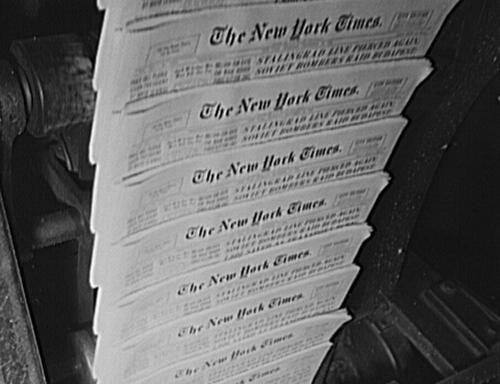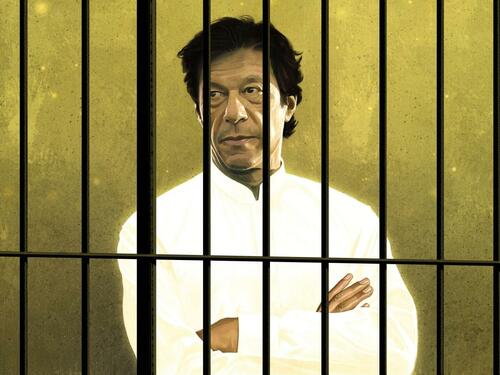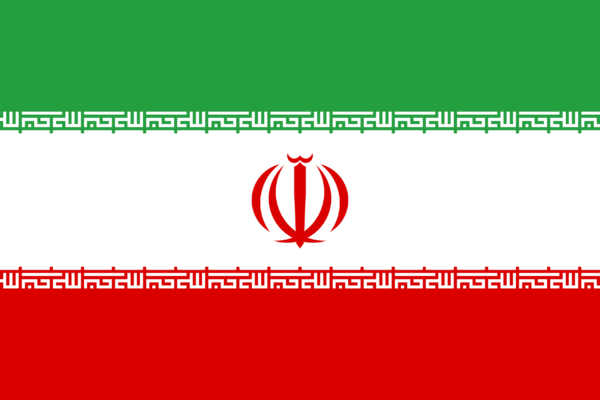Authored by J. Peder Zane via RealClearPolitics,
The following is a chapter from the recently released book, “Against the Corporate Media: Forty-two Ways the Press Hates You.”
Readers of the New York Times know the news may change, but the message is always the same in their paper of record. It will play up every Republican kerfuffle and downplay Democratic scandals while presenting the choice between the two parties as a Manichean struggle between good and evil. Now clad in rainbow colors, the Gray Lady will, in the name of inclusion, celebrate a wide range of heretofore marginal behaviors – homosexuality, polyamory and transgenderism – while sowing divisions by separating Americans into warring camps based on race, gender, and ethnicity.
The transformation of the Times, and much of American journalism, during the last decade from a traditional newspaper that largely reports the news into the daily call sheet for the “woke” revolution that seeks to undermine the traditional pillars of American society is now so complete that it may seem unremarkable. Both its defenders and critics know exactly what to expect when they open its pages. Such acceptance, or resignation, is dangerous because it normalizes the great sin of the New York Times: the betrayal of hitherto bedrock journalistic principles of fairness, objectivity and pluralism that made the Fourth Estate a pillar of American democracy during the 20th century.
The paper’s radical reinvention of itself into a results-oriented tool serving leftwing social change has happened quickly – the Times of 2010 bears little resemblance to the paper published today. But enough time has passed so that we can identify both the key incidents and the dynamic political, cultural and economic forces that have transformed America’s most influential newspaper, and thus the nation itself.
That story began to come into focus on August 7, 2016 – the day American journalism crossed the Rubicon. That’s when the New York Times published a front-page article arguing that Donald Trump was such an “abnormal” candidate that “normal standards” of reporting on him were henceforth “untenable.” From now on, the paper made clear, the news columns of the Times would be taking sides. “If you view a Trump presidency as something that’s potentially dangerous,” Jim Rutenberg wrote, “then your reporting is going to reflect that. You would move closer than you’ve ever been to being oppositional.”
The article never explained why the normal standards of objectivity were insufficient. If Trump were truly a danger to the Republic, wouldn’t an honest accounting of his behavior be enough to expose him? As would become clear in the years that followed, the true danger to the nation would come from the license Rutenberg’s piece gave to reporters at the Times and the many news outlets that followed its lead to betray the core tenets of modern journalism not just in covering Trump, but regarding a wide array of issues. “All the news that’s fit to print” became redefined as all the news that advances the left’s narrative on race and crime, climate change and gender, capitalism, and even the history of the United States.
The breadth of this effort was suggested by researcher Zach Goldberg, whose keyword searches of the Times’ archive revealed the newspaper’s politically correct embrace of hot-button terms associated with the Black Lives Matter movement. In 2010, Goldberg found that fewer than two hundred articles per year mentioned the word “social justice”; by 2018, the recorded total had more than quadrupled. He found similar increases in articles that mentioned “diversity and inclusion,” “whiteness,” “white privilege,” “white supremacy,” “systemic racism,” “discrimination,” “critical race theory,” “unconscious bias” and “implicit bias.” In 2010, Goldberg found some four hundred Times articles which included the word racism; by 2018, the total had risen six-fold.
The Times did not just radically change what it covered, but also how it covered it. Views on race and other issues that conflicted with the progressive narrative were increasingly seen through the Trumpian lens as “abnormal” and “potentially dangerous.” As Rutenberg suggested, journalism’s time-honored commitment to “objectivity” fell before the argument that respectfully airing a range of views on consequential issues was to fall prey to the sin of “both-siderism,” “whataboutism,” or “moral equivalence” – i.e., giving people deemed as liars (conservatives) the same space as truth-tellers (progressives).
Echoing language once restricted to discussion of the Holocaust, the Times brands anyone who questions global warming orthodoxy or the results of the 2020 presidential race as “climate-change deniers” and “election-deniers.” Those who challenge the wisdom of allowing young children claiming gender dysphoria to receive irreversible “medical treatment” or who assert that America has, in fact, removed racial impediments to advancement, are cast as bigots.
Yes, the Times has always had a liberal bias, and its history is filled with egregious examples of distorted coverage. As Ashley Rindsberg documented in his 2021 book, The Gray Lady Winked: How the New York Times’s Misreporting, Distortions and Fabrications Radically Alter History, these include the downplaying of Stalin’s crimes during the 1930s, largely ignoring the Holocaust during World War II, romanticizing Fidel Castro during the 1950s, and retailing a long history of anti-Israel coverage.
But its recent turn is different thanks to its aggressive ambition and scope. Rather than serving as an honest broker whose mission is to provide readers with the information needed to make decisions about important issues, it insistently puts its thumb on the scale, both in terms of the stories covered and those ignored. By replacing skepticism with ideology, the Times seeks not to inform, but to persuade. Its aim is not to reflect society but to transform it, and views to the contrary are verboten, beyond the pale of acceptable discourse.
Because the Times is, by far, the most influential news outlet in the United States, its embrace of progressive ideology has had a cascade effect, transforming the coverage and sensibility of thousands of newspapers and websites, TV and radio stations, entertainment companies, and corporations that follow its lead. Deliberately, it has legitimized and mainstreamed far-left views.
As Goldberg demonstrated, the Times’ commitment to the ongoing cultural revolution is deeply embedded in the sensibility and assumptions of almost every article it publishes. These include unnuanced celebrations of polyamory and drag queens and mainstreaming gender confusion among children in its “New York Times for Kids” special section. But two especially significant failures – The 1619 Project and the paper’s coverage of the Trump/Russia conspiracy theory – capture the extreme, dangerous path the paper of record now follows.
In August 2019, the newspaper devoted an entire issue of the New York Times Magazine to The 1619 Project. Its stated “goal” was “to reframe American history by considering what it would mean to regard 1619 [the year enslaved sub-Saharan Africans first landed in North America] as our nation’s ”real” birth year. Doing so,” the magazine’s editor Jake Silverstein wrote in an introduction, “requires us to place the consequences of slavery and the contributions of black Americans at the very center of the story we tell ourselves about who we are as a country.” Through eighteen articles and fifteen artistic contributions that spanned the length of American history, the project abandoned journalism’s traditional mission of presenting the complexity of consequential issues in order to make the argument that the nation’s past, present, and future have been and forever will be defined by anti-black racism. There were no dissenting views, and few countervailing facts.
The vast ambition of The 1619 Project underscores the Times’ transformation into a tool of the cultural revolution whose aim is to disrupt traditional understandings and beliefs about almost every aspect of American life. The hubris is astonishing. While newspapers have often revisited episodes of the past in response to scholars having unearthed new information, the 1619 Project started with an ideological position about the sweep of American history which it then set out to demonstrate through tendentious pieces. The lead essay was not written by a scholar, but an activist black journalist, Nikole Hannah-Jones.
The backlash was immediate, as many leading historians wrote lengthy critiques of nearly every article. This included a letter to the Times signed by five prominent scholars – including James M. McPherson and Sean Wilentz of Princeton University and Gordon Wood of Brown University – which challenged two of Hannah-Jones’ most sweeping assertions regarding the Revolutionary War and Abraham Lincoln.
“On the American Revolution, pivotal to any account of our history, the project asserts that the founders declared the colonies’ independence of Britain ‘in order to ensure slavery would continue.’ This is not true. … The project criticizes Abraham Lincoln’s views on racial equality but ignores his conviction that the Declaration of Independence proclaimed universal equality, for blacks as well as whites, a view he upheld repeatedly against powerful white supremacists who opposed him.”
The historians wrote that “These errors, which concern major events, cannot be described as interpretation or ‘framing.’ They are matters of verifiable fact, which are the foundation of both honest scholarship and honest journalism. They suggest a displacement of historical understanding by ideology.”
Rather than engage these prominent scholars, Hannah-Jones dismissed them as “white historians.” A few months later, their interpretation of the Project’s ideological spirit was underscored by Leslie M. Harris, an African-American historian at Northwestern University who helped fact-check Hannah-Jones essay. She wrote in Politico that she was stunned by Hannah-Jones’ assertion “that the patriots fought the American Revolution in large part to preserve slavery in North America,” because “I had vigorously argued against [it] with her fact-checker.”
In response to a letter from the five historians, Silverstein admitted that “we can hardly claim to have studied the Revolutionary period as long as some of the signatories, nor do we presume to tell them anything they don’t already know. … we disagree with their claim that our project contains significant factual errors and is driven by ideology rather than historical understanding.”
Instead of directly engaging their scholarship built on decades of professional experience and research, Silverstein advanced the postmodern view that there is no truth. “As the five letter writers well know, there are often debates, even among subject-area experts, about how to see the past. Historical understanding is not fixed; it is constantly being adjusted by new scholarship and new voices.”
Scholarship and journalism, however, are not supposed to be echo chambers for any current view, they are professional disciplines because they employ multiple processes of verification. They compare interpretations and opinions against the known body of facts – which can change – to determine the most accurate version of reality. Silverstein rejected that standard because he and his team didn’t want to search for the truth, they wanted to make an argument. “The very premise of The 1619 Project, in fact, is that many of the inequalities that continue to afflict the nation are a direct result of the unhealed wound created by 250 years of slavery and an additional century of second-class citizenship and white-supremacist terrorism inflicted on black people.”
This helps explain why the Times ignored most leading scholars of the period when preparing its sweeping reframing of American history. In interviews after publication, Hannah-Jones was even more explicit in the results-oriented structure of The 1619 Project when she stated that her goal “is that there’ll be a reparations bill passed” compensating African Americans for past mistreatment. In another sign of the power of the Times, the call for African-American reparations, long a fringe movement, became a mainstream issue in the wake of publication as many communities and states openly considered the idea, including California, which assembled a commission that called for more than $800 billion in payments.
The Times’ influence and power were also apparent when Hannah-Jones was awarded a Pulitzer Prize for her lead essay despite her profound errors.
The Times shared another Pulitzer Prize, with the Washington Post, in 2018 for its coverage of the Trump/Russia conspiracy theory. Although reports from two special counsels, Robert S. Mueller and John Durham, rejected the claim that Donald Trump had conspired with Russia’s Vladimir Putin to steal the 2016 election, the two papers earned journalism’s top prize for what the Pulitzer board described as their “deeply sourced, relentlessly reported coverage in the public interest that dramatically furthered the nation’s understanding of Russian interference in the 2016 presidential election and its connections to the Trump campaign, the President-elect’s transition team and his eventual administration.”
As with The 1619 Project, the Times’ Russiagate coverage was so one-sided, so driven by the goal of making the case against Trump, that the news that Mueller cleared Trump of the major claims against him came as a shock to many Times readers. Still, its corruption is easy to see in its refusal to address failures and to correct clear errors.
For one thing, the newspaper often relied on anonymous sources for its assertions. On Feb. 14, 2017, it published one of the foundational articles of the conspiracy theory, reporting that, “Phone records and intercepted calls show that members of Donald J. Trump’s 2016 presidential campaign and other Trump associates had repeated contacts with senior Russian intelligence officials in the year before the election, according to four current and former American officials.” Four months later, then-FBI Director James B. Comey, told Congress that “in the main,” the Times report “was not true.” Documents declassified in 2020 show that Peter Strzok, the top FBI counterintelligence agent who opened the Trump-Russia probe, described the article at the time as “misleading and inaccurate.”
Similarly, on Dec. 30, 2017, the Times published another article based on anonymous sources that purported to describe the event that led the FBI to open the probe Strzok led. It began:
“During a night of heavy drinking at an upscale London bar in May 2016, George Papadopoulos, a young foreign policy adviser to the Trump campaign, made a startling revelation to Australia’s top diplomat in Britain: Russia had political dirt on Hillary Clinton. About three weeks earlier, Mr. Papadopoulos had been told that Moscow had thousands of emails that would embarrass Mrs. Clinton, apparently stolen in an effort to try to damage her campaign.”
The Australian diplomat, Alexander Downer, directly contradicted these details in subsequent interviews. He said he and Papadopoulos each had one early evening drink at the London bar, during which Papadopoulos never mentioned “dirt” or “thousands of emails,” just that “the Russians might use material that they have on Hillary Clinton in the lead-up to the election, which may be damaging.” The electronic communication the FBI used to officially open the probe on July 31, 2016, was even less precise. It stated that Papadopoulos had “suggested the Trump team had received some kind of suggestion from Russia that it could assist with the anonymous release of information during the campaign that would be damaging to Mrs. Clinton (and President Obama). It was unclear whether he or the Russians were referring to material acquired publicly or through other means.”
In fairness to the Times, the Russiagate hoax was advanced by current and former officials at the highest reaches of government – including the CIA and the FBI – who almost certainly served as anonymous sources for the newspapers. Because reporters rely on others for information, they can be duped. But, once such manipulation is clear, all promises of confidentiality are off, and journalists are under no obligation to protect sources who intentionally used and misled them. Indeed, they have a public duty to identify the source for many reasons. The first is to make their first draft of history as accurate as possible. In the case of the Russiagate hoax, this meant identifying those who perpetrated the fraud. What did they seek to gain? What weaknesses in current systems did they exploit? There are also journalistic concerns: to keep faith with their audience, news organizations must explain why they transmitted false information. They also have a professional interest in exposing liars to deter other sources from misleading them. Not only has the Times never revealed its deceitful sources but years later, the newspaper has still not corrected these and other identified errors in its reporting.
This willful refusal to set the record straight is a stark illustration of the newspaper’s ideological transformation. The Times, of course, famously runs a column of corrections each day. During its long history, it has also, on several occasions, reinvestigated and owned up to lapses in its own work, including a very public reassessment of its reporting on whether a Taiwanese-American atomic scientist named Wen Ho Lee had spied for the Chinese communists; and, in a seven-thousand word front-page story about how a troubled affirmative-action reporter named Jayson Blair had produced a number of fabricated and plagiarized stories. That led to his forced resignation in May 2003.
The Times, however, engaged in no such soul-searching regarding Russiagate – even after one of its former star reporters, Jeff Gerth, wrote a twenty-four thousand-word piece in the Columbia Journalism Review that took the newspaper and other news outlets to task for their Trump-Russia coverage that “includes serious flaws.” It appears the story was too big to correct. Nevertheless, the problems with the Russiagate coverage were so apparent that the Pulitzer board took the highly unusual step of commissioning what it called two “independent reviews” of prize-winning articles submitted by the Times and the Washington Post. However, in yet another sign of how the Times’ corruption has become standard operating procedure at the highest levels of American journalism, the board refused to release the reports or to identify their writers. Instead, it simply issued a brief statement declaring that “no passages or headlines, contentions or assertions in any of the winning submissions were discredited by facts that emerged subsequent to the conferral of the prizes.”
The Pulitzer Board’s cover-up for the Times shows why the newspaper’s sins are especially grave and consequential. As journalism’s pied piper, the Times plays the tune – sets the narrative, normalizes the practices that others follow. If the Times had simply not rejected the “normal standards” of journalism – if it had accepted that its primary role is to inform, not to persuade – our national conversation would be far less angry. Instead, Americans are being gaslighted at the highest level, as the Times embraces the Rutenberg approach while at the same time invoking the traditional values it violates at every turn. For even as the Times twists the news, its authority still depends on being seen as an honest broker of the news – which is yet another reason why it is so loath to admit serious errors. As it betrays that trust, it must double down on claims of being trustworthy. In his 2023 State of the Times address, the paper’s chairman and publisher, A.G. Sulzberger, declared:
“The information ecosystem has been overtaken by misinformation, propaganda, punditry and clickbait, making it harder than ever to sort fact from fiction. And in this increasingly polarized era, fewer institutions are engaged in the difficult work of searching for the truth with an open mind and a first order commitment to independence, fairness and accuracy.”
Sulzberger, however, diagnosed the illness without any suggestion as to how the Times is spreading the disease. Instead of responding to legitimate critiques of its coverage, the newspaper continues to dismiss them as right-wing talking points. That said, it would be wrong to blame the Times for all of these ills. Despite its enormous influence as a thought leader, it is also a fragile follower, trying to remain profitable at a time when the news business continues to suffer significant financial losses during a period of social and technological change.
The Times did not invent the post-modern critiques of objectivity. It did not create the social media platforms that have empowered radical activists. It did not corrupt America’s education system – from K-12 to most colleges and universities – which have become factories of leftwing indoctrination. It did not spark the “Great Awokening,” that culture of identity and tribal politics, of grievance and guilt, which increasingly defines the worldview of its readers. It has, instead, capitulated to and facilitated the mainstreaming of these dangerous and dishonest forces.
Part of this is a business decision. As the Times has transformed itself into a digital operation, it is now far more dependent on revenues from partisan subscribers than advertisers who have long balked at controversy. These readers increasingly demand that the paper present news that confirms their views. Former opinion editor Bari Weiss described how the Times has changed in her 2020 resignation letter to Sulzberger:
“Twitter has become its [the newspaper’s] ultimate editor. As the ethics and mores of that platform have become those of the paper, the paper itself has increasingly become a kind of performance space. Stories are chosen and told in a way to satisfy the narrowest of audiences, rather than to allow a curious public to read about the world and then draw their own conclusions. I was always taught that journalists were charged with writing the first rough draft of history. Now, history itself is one more ephemeral thing molded to fit the needs of a predetermined narrative.”
Weiss noted that the newspaper’s staff – which, like the paper’s readers, increasingly sees journalism as an instrument of social change – also have pressured the newspaper to abandon traditional values. On June 3, 2020, for example, the newspaper asked GOP Senator Tom Cotton of Arkansas to write a piece responding to the riots then spreading across the country following the death of a black man, George Floyd, at the hands of a white police officer in Minneapolis. Cotton opined that “these rioters, if not subdued, not only will destroy the livelihoods of law-abiding citizens but will also take more innocent lives. … One thing above all else will restore order to our streets: an overwhelming show of force to disperse, detain and ultimately deter lawbreakers.”
The backlash inside the newsroom was immediate. Dozens of Times journalists Tweeted a screenshot of Cotton’s piece with the comment: “Running this puts Black @NYTimes staff in danger.”
The claim that words with which one disagrees are a form of violence is both an assault on the First Amendment and a common tool of censorship for the left. On June 4, Sulzberger felt compelled to defend Cotton’s piece in a staff memo. “I believe in the principle of openness to a range of opinions, even those we may disagree with, and this piece was published in that spirit,” he wrote. “But it’s essential that we listen and to reflect on the concerns we’re hearing, as we would with any piece that is the subject of significant criticism.”
When that failed to mollify the mob, editorial page Editor James Bennet, whose department had commissioned the piece, issued an abject apology at a June 5 staff meeting. “I just want to begin by saying I’m very sorry, I’m sorry for the pain that this particular piece has caused,” he said, adding, “I do think this is a moment for me and for us to interrogate everything we do in Opinion.” Although Cotton described a rigorous back-and-forth process that included at least three drafts of the op-ed and line-by-line editing, the Times asserted that an internal review “made clear that a rushed editorial process led to the publication of an Op-Ed that did not meet our standards.”
On June 7, Bennet, who had once been seen as a strong candidate to become the paper’s executive editor, was forced to resign. Reflecting on the experience in a 2022 interview with the online media site Semafor, Bennet said:
“My regret is that editor’s note. My mistake there was trying to mollify people,” he said.
The Times and its publisher, Bennet said, “want to have it both ways.” Sulzberger is “old school” in his belief in a neutral, heterodox publication. But “they want to have the applause and the welcome of the left, and now there’s the problem on top of that that they’ve signed up so many new subscribers in the last few years and the expectation of those subscribers is that the Times will be Mother Jones on steroids.”
The Times steadfastly refuses to grapple with the critiques of former insiders such as Bennet and Weiss, who have pointed out how its stated commitment to traditional standards is at odds with the daily journalism it produces. Lewis Menand echoed these concerns in a 2023 essay in The New Yorker, “When Americans Lost Faith in the News”:
“What people want is advocacy. … In the end, we don’t care what the facts are, because there are always more facts. You can’t unspin the facts; you can only put a different spin on them. What we want is to see our enemy—Steve Bannon, Hunter Biden, whomever—in an orange jumpsuit. We want winners and losers. That is why much of our politics now takes place in a courtroom.”
During the last decade, the Times has transformed itself into a very different publication. It is not an honest broker but an organ of advocacy. To its critics, this is a tragedy for journalism and the nation. But, as a free-standing business, that is also its right. Perhaps the Times could defend these changes. Its refusal to do so, to report on the world as it is, not as it would like it to be, does a grave disservice both to journalism and the nation.
J. Peder Zane is a RealClearInvestigations editor and columnist. He previously worked as a book review editor and book columnist for the News & Observer (Raleigh), where his writing won several national honors. Zane has also worked at the New York Times and taught writing at Duke University and Saint Augustine’s University.















